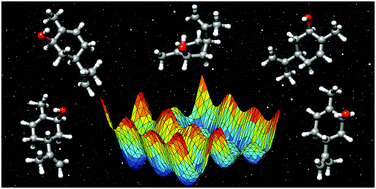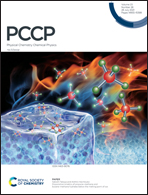A rotational spectroscopic and ab initio study of cis- and trans-(−)-carveol: further insights into conformational dynamics in monoterpenes and monoterpenoids†
Abstract
Broadband rotational spectra of cis- and trans-(−)-carveol were recorded using a chirped pulse Fourier transform microwave spectrometer in the 2–6 GHz region. To aid in spectroscopic assignments a theoretical conformational search was carried out using a combination of a two dimensional potential energy scan, scanning over the isopropenyl and hydroxyl groups torsional angles, and the Conformer–Rotamer Ensemble Sampling Tool. The theoretical results yielded a total of 23 conformers for the trans- and 19 for the cis-conformer. Utilizing these results, a total of five conformers could be assigned in the spectra, two for trans- and three for cis-(−)-carveol. In both conformers of trans-carveol, the isopropenyl group is in an equatorial position and adopts the gauche− conformation in one and the the antiperiplanar conformation in the other, with the hydroxyl group in the axial position and adopting the antiperiplanar conformation in both. For cis-carveol the analogous conformers were found but with the hydroxyl in a equatorial position, in addition to an axial isopropenyl conformer. To interpret the experimental intensity patterns and examine conformational cooling effects, transition states were identified using the Synchronous Transit Quasi-Newton method. We found that most of the higher energy conformers cool out to the five experimentally observed ones and the others are too high in energy to be sufficiently populated in the molecular expansion for an experimental observation. To investigate the interesting preference for the axial position of the isopropenyl group in cis-(−)-carveol, which has not been seen before in monoterpenoids, non-covalent interactions and quantum theory of atoms-in-molecules analyses were carried out. These analyses reveal a hydrogen bonding interaction between the hydroxyl group and the isopropenyl π-system. A natural bond orbital analysis of the hydrogen bond allowed us to decompose the interaction into its constituent natural bond orbitals, and to quantify its strength. Although relatively weak, the hydrogen bond tips the balance towards the axial position of the isopropenyl group.



 Please wait while we load your content...
Please wait while we load your content...